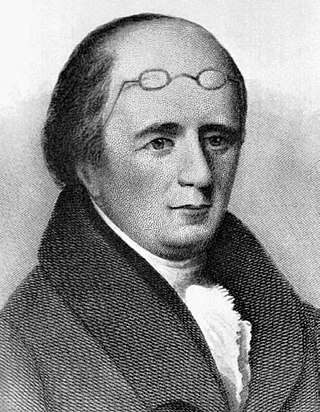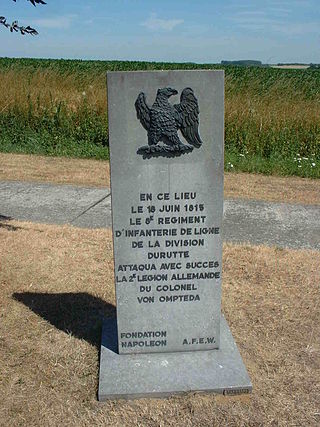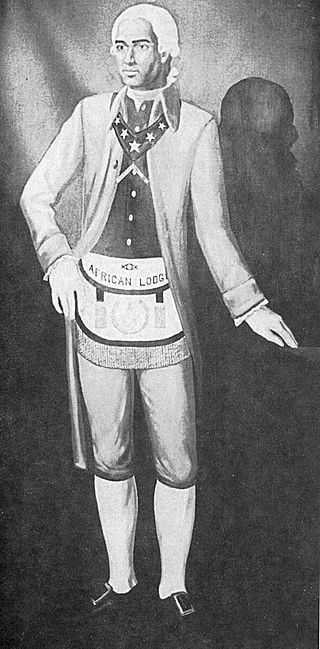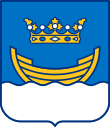
Freemasonry or Masonry refers to fraternal organisations that trace their origins to the local guilds of stonemasons that, from the end of the 14th century, regulated the qualifications of stonemasons and their interaction with authorities and clients. Modern Freemasonry broadly consists of two main recognition groups: Regular Freemasonry, which insists that a volume of scripture be open in a working lodge, that every member professes belief in a Supreme Being, that no women be admitted, and that the discussion of religion and politics do not take place within the lodge; and Continental Freemasonry, which consists of the jurisdictions that have removed some, or all, of these restrictions.

Catacombs are man-made underground passages primarily used for religious purposes, particularly for burial. Any chamber used as a burial place is considered a catacomb, although the word is most commonly associated with the Roman Empire.

William Morgan was a resident of Batavia, New York, whose disappearance and presumed murder in 1826 ignited a powerful movement against the Freemasons, a fraternal society that had become influential in the United States. After Morgan announced his intention to publish a book exposing Freemasonry's secrets, he was arrested on trumped-up charges. He disappeared soon after and was believed to have been kidnapped and killed by Masons from western New York.

The Eye of Providence or All-Seeing Eye is a symbol depicting an eye, often enclosed in a triangle and surrounded by a ray of light or a halo, intended to represent Providence, as the eye watches over the workers of mankind. A well-known example of the Eye of Providence appears on the reverse of the Great Seal of the United States, which is depicted on the United States one-dollar bill.

A headstone, tombstone, or gravestone is a stele or marker, usually stone, that is placed over a grave. It is traditional for burials in the Christian, Jewish, and Muslim religions, among others. In most cases, it has the deceased's name, date of birth, and date of death inscribed on it, along with a personal message, or prayer, but may contain pieces of funerary art, especially details in stone relief. In many parts of Europe, insetting a photograph of the deceased in a frame is very common.

A stele, or occasionally stela when derived from Latin, is a stone or wooden slab, generally taller than it is wide, erected in the ancient world as a monument. The surface of the stele often has text, ornamentation, or both. These may be inscribed, carved in relief, or painted.

Prince Hall was an American abolitionist and leader in the free black community in Boston. He founded Prince Hall Freemasonry and lobbied for education rights for African American children. He was also active in the back-to-Africa movement.

The Swedish Rite is a variation or Rite of Freemasonry that is common in Scandinavian countries and to a limited extent in Germany. It is different from other branches of Freemasonry in that, rather than having the three self-contained foundation degrees and seemingly-endless side degrees and appendant bodies, it has an integrated system with ten degrees. It is also different in that, rather than moving through the offices or 'chairs', progress in the Swedish Rite is based on moving through the ten degrees. A fundamental difference is the Swedish Rite's position on religious affiliation: Anglo/American 'Regular' Masonry requires a belief in any theistic religion and Continental 'Liberal' Masonry does not require belief in any religion, whereas Swedish Masonry is specifically Christian, and requires a Christian trinitarian belief in all its members. Nonetheless, the main Swedish Rite constitutions are all recognised as regular by the United Grand Lodge of England, and stand in full amity.

A war grave is a burial place for members of the armed forces or civilians who died during military campaigns or operations.
Freemasonry in Sweden was introduced by the Swedish Order of Freemasons, founded in 1735 as the oldest still active Swedish fraternal order, working the Swedish Rite of Freemasonry. It is under royal patronage of the King of Sweden and closely associated with the Lutheran Church of Sweden. It is a jurisdiction that admits Christian men only, and is recognised by the United Grand Lodge of England as a Regular Masonic jurisdiction, being the only Regular Grand Lodge that admits a 34th informal Masonic Degree. Its total membership is about 16,500.

The gravestone of Thomas Brierley in Mellor, Greater Manchester, is one of the few in the United Kingdom known to incorporate masonic pigpen cypher in its inscription.

Masonic ritual is the scripted words and actions that are spoken or performed during the degree work in a Masonic lodge. Masonic symbolism is that which is used to illustrate the principles which Freemasonry espouses. Masonic ritual has appeared in a number of contexts within literature including in "The Man Who Would Be King", by Rudyard Kipling, and War and Peace, by Leo Tolstoy.

Samtavro Monastery is a Georgian Orthodox Christian monastery complex that combines Samtavro Transfiguration Church and Nunnery of St. Nino in Mtskheta, Georgia. Built presumably in the 4th century by the King Mirian III, and reconstructed in the 11th century by the King George I and Catholicos-Patriarch Melchizedek I, Samtavro is an important Early and High Medieval historical and architectural monument, and was inscribed on the UNESCO World Heritage List in 1994 along other historical monuments in Mtskheta. Samtavro church is cross-in-square temple, with arches and other decorations typical for the 11th century Georgian architecture. The graves of Mirian III and the famous Georgian Saint monk Gabriel are located in the yard of Samtavro Church.

The Old Calton Burial Ground is a cemetery in Edinburgh, Scotland. It located at Calton Hill to the north-east of the city centre. The burial ground was opened in 1718, and is the resting place of several notable Scots, including philosopher David Hume, scientist John Playfair, rival publishers William Blackwood and Archibald Constable, and clergyman Dr Robert Candlish. It is also the site of the Political Martyrs' Monument, an obelisk erected to the memory of a number of political reformers, and Scotland's American Civil War Memorial.

St. Olaf's Church, also known as Ulvila Church, is a church of the Evangelical Lutheran Church of Finland in Ulvila, Finland. The church is considered one of the best-preserved medieval fieldstone churches in Finland and is the only remaining structure from the medieval town of Ulvila. St. Olaf has been the patron saint of the church since before 1429.

Kalevankangas Cemetery is a cemetery in the Kalevanharju district within the city of Tampere, Finland.

The Pohjois-Haaga mass grave is a grave in Lassila, Helsinki, Finland, near the Pohjois-Haaga railway station that dates to the time of the Finnish Civil War in 1918. 28 men of the Red Guards or civilians thought to have been affiliated with them executed by the German Baltic Sea Division soldiers are buried at the site.

Hatanpää Manor was a manor in the area of the current city of Tampere on the shores of Lake Pyhäjärvi in Pirkanmaa, Finland. It was founded in the 1690s, but the current main building of Hatanpää Manor, designed by architect Sebastian Gripenberg, was completed in 1885. The manor has preserved the manor park on the Hatanpää's peninsula, as well as the main building and villa building built in the late 19th century. The former land areas of the manor are now residential and industrial areas.

Keisarinnankivi is a monument located at the Market Square in Kaartinkaupunki in central Helsinki, Finland. The monument, designed by Carl Ludvig Engel, is the oldest public monument in Helsinki. It was revealed with celebrations on the name day of Nikolai on 18 December 1835 to commemorate the first visit to Helsinki by Empress Alexandra Feodorovna, wife of Emperor of Russia Nicholas I. The monument was erected at the spot where the imperial couple stepped ashore from the steamship Ischora on arrival in Helsinki on 10 June 1833. The monument was funded by a national collection of funds and by a grant given by the Imperial Senate of Finland.

The Ehrensvärd grave is the final resting place and memorial of Augustin Ehrensvärd, the founder of the Suomenlinna island fortress in Helsinki, Finland, at the Linnanpiha yard on the island of Susisaari in Suomenlinna. Ehrensvärd was buried at the yard in 1783 but the memorial was only completed in its current form in 1805.




















